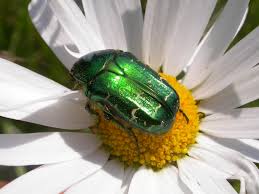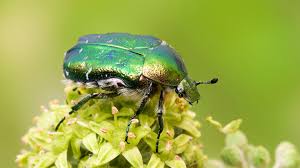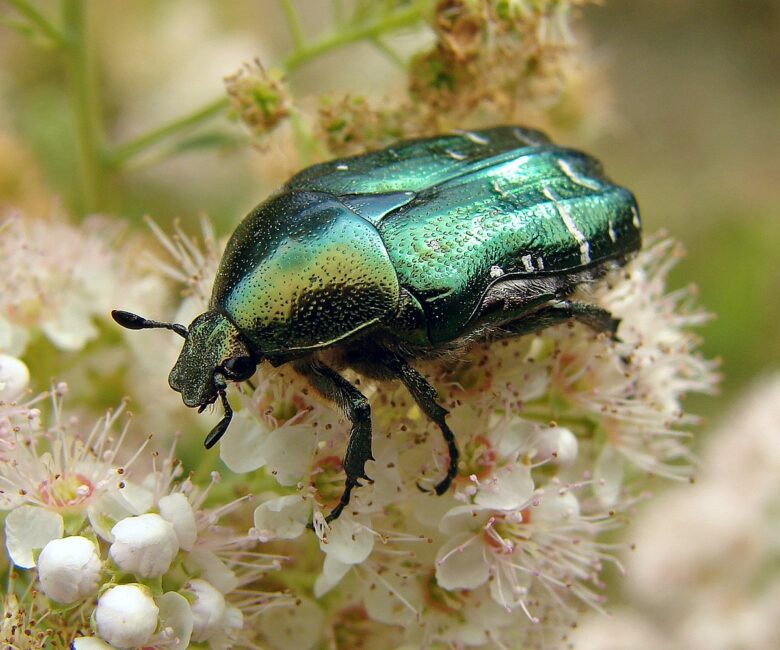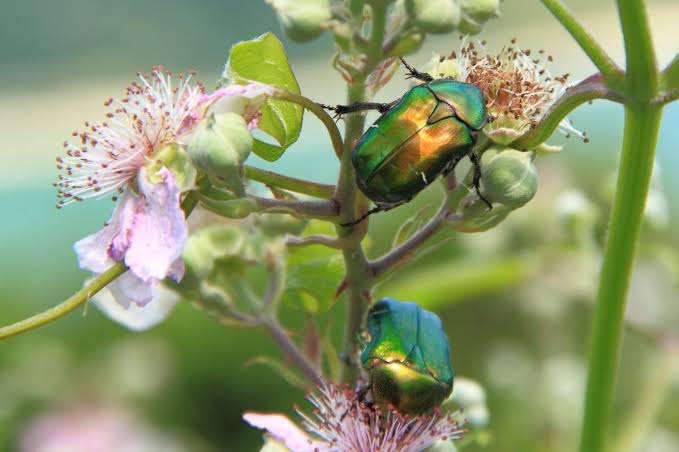The Rose chafer, scientifically known as Cetonia aurata, is a fascinating beetle that captivates observers with its striking appearance and interesting behaviors. This charming insect belongs to the Scarabaeidae family and is commonly found in various parts of Europe and Asia.
Distinguished by its iridescent green or golden coloration, the Rose chafer showcases a shimmering beauty that stands out in gardens and meadows. Its smooth, metallic exoskeleton reflects sunlight, creating a mesmerizing spectacle for those fortunate enough to encounter this insect in the wild.
In terms of size, the Rose chafer typically measures around 1 to 1.5 centimeters in length, making it a relatively small yet eye-catching creature. Its compact body is adorned with fine hairs, adding a delicate touch to its overall appearance.
One of the most intriguing aspects of the Rose chafer’s lifestyle is its feeding habits. As adults, these beetles are primarily herbivores, with a strong affinity for flower petals and nectar. Their favorite dining spots include roses, from which they derive their common name. This feeding behavior not only sustains the Rose chafer but also plays a role in pollination, contributing to the ecological balance of its habitat.
During the warmer months, Rose chafers engage in a lively and acrobatic flight, darting from flower to flower in search of sustenance. Their buzzing wings create a gentle hum, adding a harmonious note to the natural symphony of the outdoors.
The life cycle of the Rose chafer is a captivating journey of transformation. Beginning as eggs laid in soil, they hatch into larvae, commonly referred to as grubs. These grubs undergo a developmental process, feeding on decaying organic matter in the soil before eventually pupating. The emergence of the adult Rose chafer marks the completion of this life cycle, signaling a new chapter in the beetle’s existence.
Despite their captivating presence, Rose chafers are not without their challenges. Gardeners may encounter them as both a delightful sight and a potential pest, as their feeding habits can sometimes lead to damage to ornamental plants. However, the overall impact of these beetles on the ecosystem is relatively balanced, contributing to pollination and nutrient recycling.
The Rose chafer, or Cetonia aurata, is a small yet enchanting beetle that graces gardens and meadows with its vibrant presence. From its iridescent coloration to its role in pollination, this insect offers a glimpse into the intricacies of the natural world, reminding us of the beauty and diversity that can be found in even the smallest of creatures.
Read Also: 11 Medicinal Health Benefits Of Baccharis articulata (Mule fat)
Plants Affected by Rose Chafer (Cetonia aurata)

The Rose chafer (Cetonia aurata) can have varying impacts on different plants, and its feeding preferences may lead to interactions with a variety of vegetation. While they are known to favor flower petals and nectar, some plants are more susceptible to the attentions of these beetles.
One notable group of plants affected by Rose chafers includes ornamental flowers, particularly roses (Rosa spp.), from which the beetle derives its common name. These beetles may feed on the petals of roses, and in some instances, their feeding activities can result in cosmetic damage to the flowers. However, it’s important to note that the impact on the overall health of well-established plants is generally minimal.
In addition to roses, the Rose chafer may also be attracted to other flowering plants such as peonies (Paeonia spp.) and various species of lilies (Lilium spp.). The beetles’ preference for nectar-rich blossoms makes them potential visitors to a diverse range of garden flowers.
While the Rose chafer’s feeding habits can be considered a mild concern for ornamental plants, it’s essential to recognize that they do not typically pose a significant threat to the overall health of most garden vegetation. In fact, their role in pollination contributes positively to the ecosystem by aiding in the reproduction of flowering plants.
In agricultural settings, Rose chafers may sometimes feed on crops such as grapes (Vitis vinifera) and other fruit-bearing plants. However, the impact on crop yields is generally limited, and large-scale damage is uncommon.
However, while the Rose chafer may interact with a variety of plants, its influence is often more noticeable on ornamental flowers, especially roses. Understanding their feeding habits helps gardeners strike a balance between appreciating the beauty of these beetles and managing any potential cosmetic impact on certain plants.
Damages Caused by Rose Chafer

The Rose chafer (Cetonia aurata) can cause certain damages, particularly in the context of ornamental gardens and, to a lesser extent, in agricultural settings. While these damages are generally not severe, understanding the potential impact of Rose chafers on plants is important for effective pest management.
One of the primary damages caused by Rose chafers is associated with their feeding habits. These beetles are known to consume flower petals, particularly those of roses (Rosa spp.), which is reflected in their common name. While the damage is primarily cosmetic and rarely threatens the overall health of well-established plants, it can be disheartening for gardeners who value the aesthetic appeal of their blooms.
In addition to roses, Rose chafers may feed on the petals of other ornamental flowers, such as peonies (Paeonia spp.) and various types of lilies (Lilium spp.). Their consumption of flower parts can result in a reduction of the visual quality of the blooms.
In agricultural settings, Rose chafers may occasionally feed on crops, including grapes (Vitis vinifera) and fruit-bearing plants. However, the impact on crop yields is typically limited, and significant economic losses are rare. Effective pest management strategies, if necessary, can help mitigate any potential damages to agricultural crops.
It’s important to note that while Rose chafers may cause some aesthetic damage to flowers, they also play a beneficial role in the ecosystem. Their involvement in pollination contributes to the reproduction of flowering plants, promoting biodiversity and supporting the overall health of natural environments.
The damages caused by Rose chafers are generally minor and cosmetic, primarily affecting the appearance of ornamental flowers. While gardeners may find their feeding activities undesirable, understanding the ecological balance and implementing appropriate management measures can help minimize any negative impact on cultivated plants.
Furthermore, the damages caused by Rose chafers extend beyond their feeding habits. In their larval stage, known as grubs, these beetles reside in the soil and feed on organic matter, including the roots of grasses. While the impact of Rose chafer larvae on the health of established lawns or grassy areas is generally limited, in certain circumstances, a high population of grubs may contribute to minor turf damage.
Gardeners and landscapers may notice patches of grass with weakened roots, leading to the development of brown or thinning areas in lawns. However, it’s crucial to distinguish between the occasional presence of Rose chafer grubs and more destructive turf pests, as the overall impact on grass health is typically not severe.
Additionally, in rare instances, large populations of Rose chafers may cause defoliation in trees and shrubs. Their voracious appetite for foliage, while not a common occurrence, can result in visible damage to certain plants, especially if the population of beetles is unusually high.
Despite these potential damages, it’s essential to approach Rose chafer management with a balanced perspective. These beetles, as part of the natural ecosystem, contribute positively to pollination and nutrient cycling. Integrated pest management strategies that take into account the overall health of the environment can help strike a balance between minimizing potential damages and preserving the ecological benefits of Rose chafers.
While Rose chafers can cause cosmetic damages to ornamental flowers and, to a lesser extent, affect lawns and foliage, their overall impact on plants is generally manageable. Understanding their life cycle, feeding habits, and implementing appropriate control measures when necessary can help maintain a healthy balance between these charming beetles and the cultivated landscapes they inhabit.
Read Also: 11 Medicinal Health Benefits Of Baccharis dracunculifolia (Brazilian Peppertree)
Control and Preventive Measures

Controlling and preventing Rose chafer (Cetonia aurata) infestations in gardens and landscapes involves a combination of proactive measures and targeted interventions. Here are some effective strategies:
1. Handpicking: One of the simplest methods is manually removing Rose chafers from affected plants. This can be done by gently shaking the beetles into a container of soapy water, where they will drown. This approach is more practical for smaller garden areas.
2. Neem Oil: Neem oil is a natural insecticide that can be applied to plants. It disrupts the feeding and reproductive behavior of Rose chafers. Regular applications, especially on susceptible plants, can help deter these beetles.
3. Row Covers: Use row covers or netting to physically protect vulnerable plants from Rose chafers. This barrier prevents the beetles from reaching the plants and causing damage. Ensure that the covers are properly secured to prevent any gaps.
4. Beneficial Predators: Encourage natural predators of Rose chafers, such as birds, to inhabit your garden. Birds, like robins and starlings, feed on adult beetles, helping to keep their population in check.
5. Trap Plants: Introduce decoy or trap plants that are attractive to Rose chafers away from valuable ornamental flowers. This can divert the beetles to a designated area, reducing the impact on desired plants.
6. Diatomaceous Earth: Sprinkle food-grade diatomaceous earth around plants. This substance, composed of tiny fossilized aquatic organisms, acts as a natural insecticide. It dehydrates and damages the exoskeleton of Rose chafers, causing them to perish.
7. Biological Controls: Consider the use of nematodes that specifically target Rose chafer larvae in the soil. These microscopic organisms are applied to the soil and parasitize the larvae, helping to reduce their numbers.
8. Maintain Healthy Soil: Rose chafer larvae thrive in sandy, well-drained soil. Amending the soil to improve its structure and water retention can make it less conducive to the development of larvae.
9. Chemical Control: In severe cases, chemical insecticides labeled for Rose chafers can be used. However, it’s essential to follow application instructions carefully, considering the potential impact on non-target insects and the environment.
Implementing a combination of these measures, tailored to the specific conditions of your garden, can effectively control and prevent Rose chafer infestations while minimizing the impact on the surrounding ecosystem. Regular monitoring of plants and prompt action are key elements of successful management.
Frequently Asked Questions (FAQs) About Rose Chafer (Cetonia aurata)
Q1: What is a Rose chafer, and why is it called that?
A1: The Rose chafer (Cetonia aurata) is a metallic green or golden beetle belonging to the Scarabaeidae family. It is named for its affinity for feeding on flower petals, particularly roses, which contributes to its common name.
Q2: Where are Rose chafers commonly found?
A2: Rose chafers are often found in various parts of Europe and Asia. They inhabit gardens, meadows, and other areas with flowering plants.
Q3: What is the scientific name of the Rose chafer?
A3: The scientific name of the Rose chafer is Cetonia aurata.
Q4: Are Rose chafers harmful to plants?
A4: While Rose chafers can cause cosmetic damage by feeding on flower petals, especially of roses, their impact on the overall health of plants is generally minimal. They also play a beneficial role in pollination.
Q5: How can I control Rose chafers in my garden?
A5: Control measures include handpicking, using neem oil, employing row covers, attracting beneficial predators, introducing trap plants, applying diatomaceous earth, considering biological controls like nematodes, maintaining healthy soil, and, in severe cases, using chemical insecticides.
Q6: Do Rose chafers pose a threat to crops?
A6: While Rose chafers may occasionally feed on crops, such as grapes, the impact on crop yields is usually limited. Large-scale damage is uncommon, and effective pest management can help mitigate any potential issues.
Q7: What is the life cycle of the Rose chafer?
A7: The Rose chafer undergoes a complete metamorphosis, progressing through egg, larva (grub), pupa, and adult stages. The larvae develop in the soil, feeding on organic matter, before emerging as adults.
Q8: Can Rose chafers fly?
A8: Yes, Rose chafers are capable fliers. In the warmer months, they engage in active flight, buzzing from flower to flower in search of nectar.
Q9: Are there natural predators of Rose chafers?
A9: Yes, natural predators of Rose chafers include birds, such as robins and starlings, which feed on the adult beetles.
Q10: How can I attract beneficial insects to my garden?
A10: Planting a diverse range of flowers that bloom throughout the season, providing water sources, and avoiding the use of broad-spectrum pesticides can attract beneficial insects, including those that prey on Rose chafers.
Read Also: Cost of Starting a Waste Management Business

